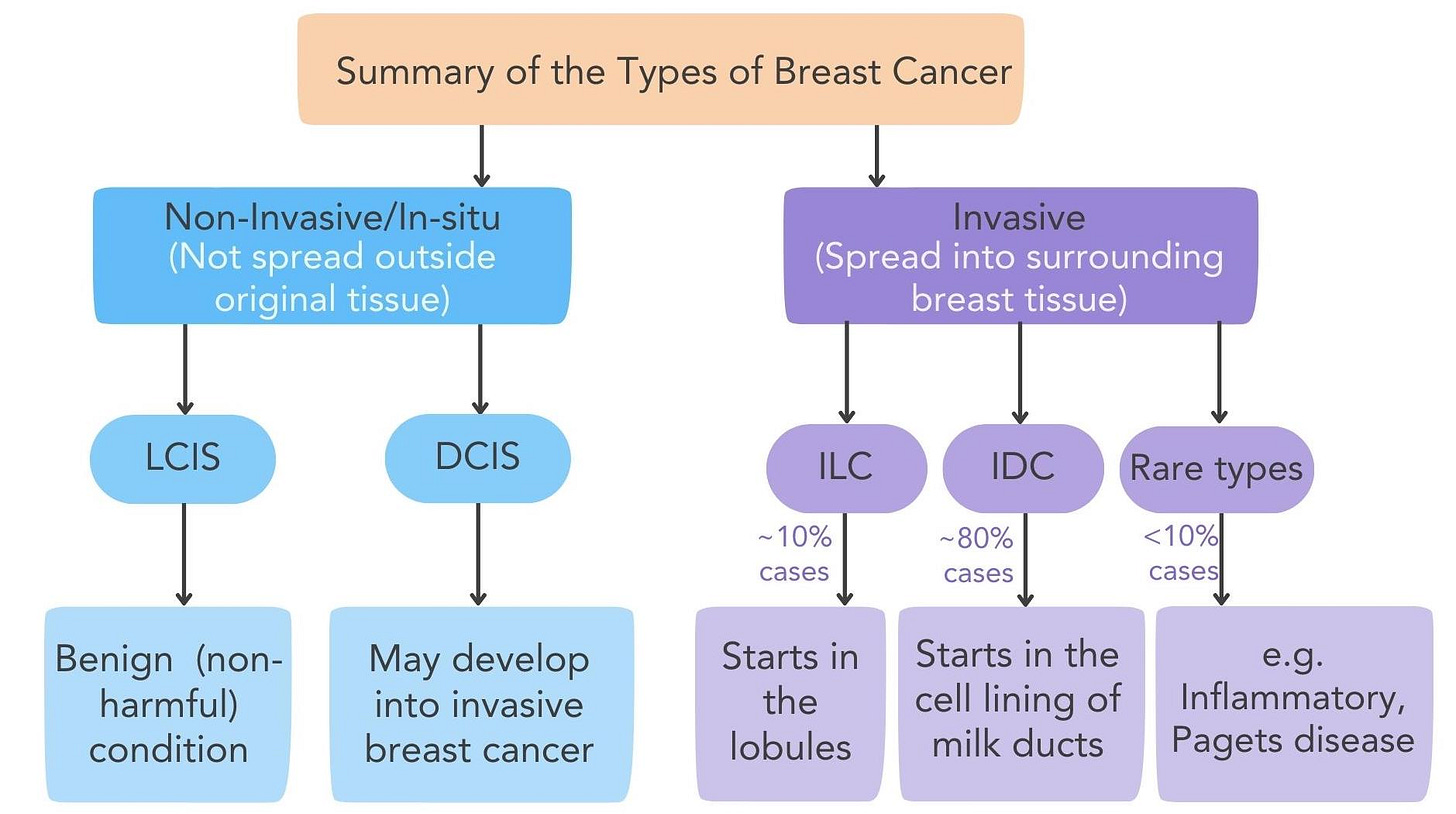Types of Breast Cancer Explained
Why knowing your type matters for treatment
Insights for Empowerment
When I was diagnosed, I learned I didn’t just have breast cancer. I had two different types of breast cancer. One in each breast.
Invasive Ductal Carcinoma in my left breast. Invasive Papillary Carcinoma in my right.
My mother had breast cancer in her 40s. But I don’t have all the details about her diagnosis. I don’t know what type she had. That information could have helped me understand my own risk better.
That’s why understanding your specific type matters—not just for your treatment, but for your family members who may be at risk too. The information you share today could protect someone you love tomorrow.
Most Common Types
Invasive Ductal Carcinoma (IDC) The most common type, accounting for about 80% of breast cancers. It starts in the milk ducts and invades surrounding tissue. This is what I had in my left breast.
Invasive Lobular Carcinoma (ILC) Starts in the milk-producing glands. About 10% of invasive breast cancers. Can be harder to detect on mammograms.
Ductal Carcinoma In Situ (DCIS) Non-invasive. Cancer cells are contained in the milk ducts. Highly treatable but requires monitoring.
Less Common Types
Invasive Papillary Carcinoma A rarer form that tends to grow in a pattern resembling tiny fingers. Often has a better prognosis. This is what I had in my right breast.
Inflammatory Breast Cancer Aggressive and fast-growing. The breast becomes red, swollen, and warm. Requires immediate treatment.
Triple-Negative Breast Cancer Doesn’t have receptors for estrogen, progesterone, or HER2. Requires different treatment approach. Tends to be more aggressive.
Hormone Receptor Status Matters
Beyond the type, your cancer’s receptor status determines treatment:
ER+ (Estrogen Receptor Positive): My cancer was ER+, meaning estrogen fueled its growth. Treatment includes hormone therapy to block estrogen.
PR+ (Progesterone Receptor Positive): Similar to ER+, responsive to hormone therapy.
HER2+ or HER2-: Affects which targeted therapies will work.
Why This Information Matters
Knowing your specific type and receptor status helps your medical team:
Choose the most effective treatment
Predict how aggressive the cancer might be
Determine if targeted therapies will help
Assess your prognosis and recurrence risk
Conclusion
If you’ve been diagnosed, make sure you understand your specific type and what it means for your treatment. Don’t be afraid to ask your doctor to explain it multiple times until it makes sense.
And here’s something else: share this information with your family. Your daughters, your sisters, your nieces. Not because previous generations did anything wrong, but because we now know how important this information is.
Knowledge is power. The more you understand about your cancer, the more empowered you’ll feel to make informed decisions. And the more you share, the more you protect the women who come after you.
Encouraging Nuggets
Questions to Ask Your Doctor:
What type of breast cancer do I have?
What is my hormone receptor status?
What does this mean for my treatment options?
What is my prognosis?
Are there targeted therapies that might help?
Remember: Every breast cancer is different. Your type, stage, and receptor status all affect your journey. There’s no one-size-fits-all approach, and that’s okay.




Thank you for this easy to understand guide! I live with HER2+ ER+ metastatic breast cancer in both of my lungs. I do not have breast cancer remaining in my breasts. It can get so confusing!!